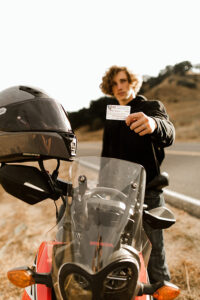AMERICAN MOTORCYCLIST November 2019
Getting licensed the right way
Carrying On A Family Tradition

By Nathan Gotoski
Motorcycling has been one of my favorite activities throughout my life.
I originally learned to ride on dirt using ATVs and dirt bikes. Going out to the desert with friends and family is one of my favorite pastimes and an annual tradition. My father and mother both ride and have ridden street bikes, so transitioning onto a street legal bike is a logical step in my riding.
Riding has always been a special part of my life, and incorporating it into my daily life as a practical and fun method of transportation would continue the long tradition of motorcycling in my extended family, a tradition that began before WWII.
To help me acquire my license, my dad enrolled me in the California Motorcyclist Safety Program at Honda’s Rider Education Center in Colton, Calif. The course spans two days, and its purpose is to teach new riders the rules and skills of motorcycling safely on the road.
Riders who complete the course don’t have to take a riding test at the state Department of Motor Vehicles—only a written test based on the California Motorcycle Handbook. This appeals to new riders and provides them with an easy opportunity to earn their motorcycle license.
The training consisted of two classroom and two riding portions divvied up over the two days.
In the classroom sessions, we reviewed basic motorcycle structure and rules for motorcyclists and learned about the requirements to ride a motorcycle. Most of this information was basic. However, it was a helpful review and is perfect for giving brand new riders an introduction and understanding of motorcycling.
The course emphasized the necessity for using proper safety apparel and why it’s a smart decision to have as much protection as possible on a motorcycle to protect yourself from the elements, other drivers and to be more comfortable on the bike. The proper techniques of basic skills—swerving, braking and cornering—also were explained.
After the class portion on the first day came the riding portion. It started with the amazing instructors pairing students to bikes. There were multiple types of motorcycles, and the instructors matched bikes to people based on height and experience to ensure the class was as comfortable as possible. After we got situated on our

Sydney Takeshta London Light Photography
motorcycles, the instructors took us through basic drills to get us familiar with motorcycle operation. The first day was simple with drills mostly consisting of starting and stopping to build rider confidence.
During the second classroom day, we studied more complicated scenarios, such as emergency stopping and riding impaired. These situations are important to study because many motorcycle fatalities are caused by incorrect cornering and riding under the influence of alcohol and other substances. The instructors also explained how simply riding with strong emotions or being tired or drowsy can affect a person’s riding abilities.
After the second classroom day, we took a 50-question test.
The second riding day consisted of drills and, eventually, a riding test. It was based on the skills we learned over the two days from the numerous practice exercises: swerving, cornering, counter steering, braking and weaving.
I enjoyed the company of the other students and their support, conversations and jokes. Bonding over motorcycling is powerful and was something that made the class enjoyable and memorable.
After the course, our class was given instructions on how to acquire a motorcycle license at the DMV. The students were also given a California Motorcyclist Safety Program completion card and paperwork for the DMV to allow a smooth and easy transition into their street license and their riding experiences.
The Honda Rider Education Center was a fast, easy and very enjoyable way to acquire my license and the classroom and riding portions gave valuable knowledge and skills to the students involved.
Nathan Gotoski, 17, is an AMA member from California. His father, Steve Gotoski, is the AMA national sales director..

Great grandfather Sheridan Sherman (left) and grandfather Jerry Gotoski working on a 1950 Panther circa 1959.
